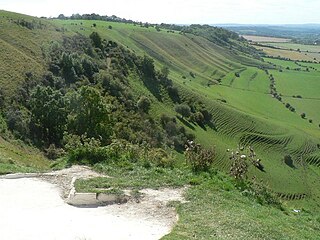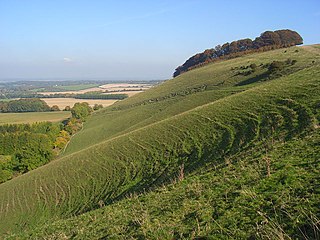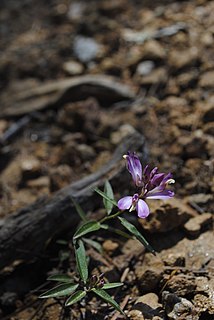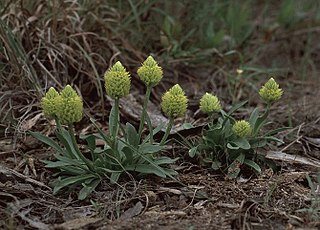
Bratton Downs is a 395.8 hectare biological and geological Site of Special Scientific Interest in Wiltshire, near the villages of Bratton, Edington and Westbury. It was notified in 1971. The designated area consists mainly of chalk grassland, as well as some ancient woodland, and supports a diverse range of native flora and fauna. It overlays notable geological features—principally landforms created by glaciation in the Pleistocene.

Ham Hill is an area of chalk downland in Wiltshire, England, on the steep banks running alongside the road from the village of Ham to Buttermere, close to the Berkshire border. A biological Site of Special Scientific Interest, notified in 1971, covers 1.5 hectares of the site; this designation is due to the site's species-rich plant and insect communities, which include some rare species. Notable among these is the musk orchid, which has been confirmed at only one other site in Wiltshire.

Polygala chamaebuxus, the shrubby milkwort, is an ornamental plant of Polygala genus in the Polygalaceae family. It has white flowers with bright yellow stigmatic lobes, and is native to the mountains of west-central Europe. It was known to be grown in cultivation in about 1658 and was illustrated by Carolus Clusius.

Polygala acanthoclada is a species of flowering plant in the milkwort family known by the common names desert polygala and thorn milkwort. It is native to the desert woodlands of the southwestern United States from Utah to the Mojave Desert. It is a small, bushy shrub spreading or growing erect and approaching one meter in maximum height. It is hairy in texture, the youngest twigs hairiest with a feltlike coat of short, whitish fibers. The lance-shaped or oval leaves are up to 2.5 centimeters long. Some of the twigs narrow to spines at the tips, especially in the inflorescences. The flowers are solitary or in clusters of up to 15. Each flower has five sepals, the lateral two white in color and spreading out like wings. The middle petal is keeled, with a flat tip protruding. The fruit is a capsule about half a centimeter long.

Polygala californica is a species of flowering plant in the milkwort family known by the common name California milkwort. It is native to southwestern Oregon and northern and central California, where it grows in the coastal mountain ranges in local habitat types such as chaparral and forest. It is a perennial herb producing spreading stems, generally decumbent in form, up to about 35 centimeters in maximum length, lined with narrow oval leaves each a few centimeter long. The upper inflorescences produce several open flowers, and there may be some closed, cleistogamous flowers lower on the plant. The open flowers have pink or white winglike lateral sepals with hairy edges. The petals are similar in color, the central one tipped with a white or yellow beak. The fruit is a flattened green capsule up to a centimeter long containing hairy seeds.
Polygala heterorhyncha is a species of flowering plant in the milkwort family known by the common names beaked spiny polygala and notch-beaked milkwort. It is native to southern Nevada and it is known from a few occurrences just over the border in the Funeral Mountains of California above Death Valley. It is a resident of desert scrub habitat. This desert plant is a perennial herb or small shrub growing in small clumpy mats. The thin, branching, thorny-tipped stems are somewhat waxy in texture and sometimes slightly hairy. They are lined sparsely with small oval, dull-pointed leaves. The inflorescence bears a few flowers, each with a winglike pair of bright pink sepals and a yellow-tipped central petal. The fruit is a vein-streaked capsule.
Polygala intermontana is a species of flowering plant in the milkwort family known by the common name intermountain milkwort. It is native to the southwestern United States from Utah to northern Arizona and far eastern California, where it grows in desert scrub and woodland habitat. It is a small shrub growing erect or forming tangled, mats of thorny, highly branched stems. The stems are hairy in texture with white fibers. The sparse leaves are linear to oval in shape. The inflorescence bears one to seven flowers, each just a few millimeters in length. The flower has a winglike pair of greenish or whitish sepals and a keeled central petal that lacks the beaked tip of other Polygala species.
Polygala subspinosa is a species of flowering plant in the milkwort family known by the common name spiny milkwort. It is native to the southwestern United States, where it grows in desert and plateau habitat. It is a perennial herb or small shrub growing in a clump no more than 25 centimeters tall. The stems have woody bases and green, thorn-tipped branches. The leaves are up to 3 centimeters in length and generally oval in shape. The flowers have winglike pairs of bright pink sepals and the keeled central petal is tipped with a yellowish beak, sometimes fringed at the tip.

Polygonum polygaloides is a North American species of flowering plants in the buckwheat family known by the common names milkwort knotweed and polygala knotweed. It is native to much of western North America, where it can be found in many types of moist habitat. It is a variable species, usually divided into a number of subspecies.

Polygala lewtonii is a rare species of flowering plant in the milkwort family known by the common name Lewton's polygala, or Lewton's milkwort. It is endemic to Florida in the United States, where it is limited to the central ridge of the peninsula. There are about 49 occurrences of the plant remaining. Most occurrences contain very few plants. The species is threatened by the loss and degradation of its habitat. This is a federally listed endangered species of the United States.

Polygala calcarea, the chalk milkwort, is a species of flowering plant in the family Polygalaceae, native to western Europe. It is a delicate mat-forming evergreen perennial growing to 5 cm (2 in) tall by 20 cm (8 in) broad, with spikes of small, vivid deep blue flowers in spring, and leathery, oval leaves. The white anthers of the flowers may possibly be the source of the name milkwort.

Polygala senega is a species of flowering plant in the milkwort family, Polygalaceae. It is native to North America, where it is distributed in southern Canada and the central and eastern United States. Its common names include Seneca snakeroot, senega snakeroot, senegaroot, rattlesnake root, and mountain flax. Its species name honors the Seneca people, a Native American group who used the plant to treat snakebite.
Polygala rectipilis, common name New Mexico milkwort, is a plant endemic to one county in New Mexico. The type specimen was collected near the Town of Hillsboro in Sierra County, at an elevation of 1065 m.

Polygala curtissii, the Curtiss' milkwort or Appalachian milkwort, is a species of flowering plant in the milkwort family. It is native to the Southeastern United States, where it is found primarily in the southern Appalachian Mountains and the Piedmont. Its natural habitat is open, sandy meadows and woodlands.

Polygala nana, commonly known as candyroot or low bachelors' buttons, is a very small herbaceous plant which is native to the southeastern United States. The root has a sweet liquorice flavor when it is chewed, but it is usually hidden underground until the plant flowers. The seeds of candyroot are dispersed by ants.

Polygala alba, commonly called white milkwort, is a species of flowering plant in the milkwort family (Polygalaceae). It is native to North America, where it is found in Canada, Mexico, and the United States. In the United States, its range is concentrated in the Great Plains and the Southwest. Its natural habitat is in rocky or sandy dry prairies.













